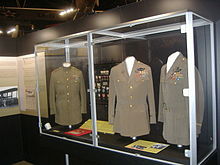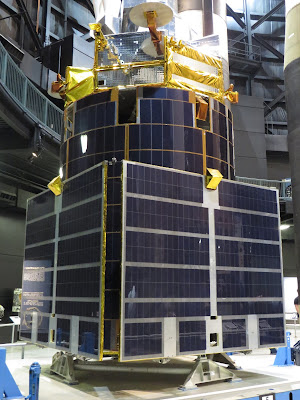Wright-Patterson Air Force Base in Dayton, Ohio, is a very active base. We, of course, were not permitted on the 'base' but that was okay because we only wanted to visit the National Museum of the United States Air Force.
The National Museum of the United States Air Force (formerly the United States Air Force Museum) is the official museum of the United States Air Force located at Wright-Patterson Air Force Base, 6 miles (9.7 km) northeast of Dayton, Ohio. The NMUSAF has one of the world's largest collections of military related aircraft, weapon system displays, engines, and other exhibits with more than 360 aircraft and missiles on display. (My thanks to Wikipedia)
The museum dates to 1923 when the Engineering Division at Dayton's McCook Field first collected technical artifacts for preservation. In 1927 it moved to then Wright Field in a laboratory building. In 1932 the collection was named the Army Aeronautical Museum and placed in a WPA building from 1935 until WWII.
In 1948 the collection remained private as the Air Force Technical Museum. In 1954 the Air Force Museum became public and was housed in its first permanent facility, Building 89 of the former Patterson Field in Fairborn, which had been an engine overhaul hangar. Many of its aircraft were parked outside and exposed to the weather. It remained there until 1971 when the current facility first opened. Not including its annex on Wright Field proper, the museum has more than tripled in square footage since its inception in 1971 with the addition of a second hangar in 1988 and a third in 2003.
The museum announced a new name for the facility in October 2004. The former name, United States Air Force Museum changed to National Museum of the United States Air Force.
The museum is a central component of the National Aviation Heritage Area. The museum's collection contains many rare aircraft of historical or technological importance, and various memorabilia and artifacts from the history and development of aviation. (Wikipedia)
The permanent collections include one of four surviving Convair B-36s, which are so large I could only get a partial shot.
Photo by Jan
The Bockscar—the B-29 Superfortress that dropped an atomic bomb on Nagasaki Japan during the last days of World War II.
Photo by Jan
Photo by Jan
'Fat Man' replica of bomb dropped on Hiroshima, the first atomic bomb dropped.
Photo by Jan
'Little Boy' was carried by Bockscar (above) and dropped on Nagasaki three days later upon which Japan surrendered and the war in the Pacific ended.
I was a bit disappointed the day we visited because we were not able to go into the Presidential Hanger as the tickets for the tour busses were all sold. The Presidential Hanger has several Presidential aircraft, including those used by Franklin D. Roosevelt, Harry Truman, and Dwight D. Eisenhower. The centerpiece of the Presidential aircraft collection is SAM 26000, a modified Boeing 707 known as a VC-137C, used regularly by Presidents John F. Kennedy through Richard Nixon's first term; after which it became the backup Presidential aircraft. This aircraft took President and Mrs. Kennedy to Dallas on November 22, 1963—the day of the President's assassination. Vice President Lyndon B. Johnson was sworn in as President aboard it shortly after the assassination—and the plane then carried President Kennedy's body back to Washington. When the slain President was retuned to Washington, a portion of the aft bulkhead in the passenger cabin was cut out with a hacksaw to get the President's coffin in. It was thought disrespectful to carry his body in the cargo hold. It was temporarily removed from display on December 5, 2009, to be repainted. It was placed back on display in the museum on President's Day, 2010.
All presidential aircraft are now displayed in the Presidential Hangar, next to the R&D/Flight Test Hangar west of the USAF Museum. As both hangars are behind the perimeter fence on Wright-Patterson AFB property, the general public can only visit them by tour bus.(Wikipedia)
A large section of the museum is dedicated to pioneers of flight, especially the Wright Brothers, who conducted some of their experiments at nearby Huffman Prairie. A replica of the Wrights' 1909 Military Flyer is below.
Photo by Jan
The building also hosts the National Aviation Hall of Fame, which includes several educational exhibits. One exhibit is the quilt commemorating the 50th anniversary of the United States Air Force.
There is also a quilt and art remembering the Holocaust.
Photo by Jan
Bob Hope is also remembered.
Photo by Jan
The museum has a large inventory of U.S. Army Air Forces and U.S. Air Force clothing and uniforms in its collection.
Photo - wikipedia
Post-Cold War era planes such as the B-2 Spirit stealth bomber (test aircraft).
Photo by Jan
And an F-117 Nighthawk stealth fighter, both very cool!!
Photo by Jan
Many aircraft are on loan to museums all over the country, but the Air Force museum's staff has very high standards for the restoration and quality of care of loaned assets and has, in the past, revoked these loans when it was deemed that these other museums did not have the resources to properly care for an artifact. This happened in the case of the famous B-17, Memphis Belle, which today is being restored. The photo below is not the Memphis Belle however is an example of a B-17.
Photo by Jan
The National Museum of the U.S. Air Force is in the midst of a multi-phase, long-term expansion plan. The Air Force Museum Foundation is currently supporting a major capital construction program to expand the museum's current one million square feet of exhibit space with a fourth building that will house the Space Gallery, and Presidential Aircraft Gallery. (Wikipeia)
 |
| (Wikipedia)
|
 |
| Photo by Jan |
Above left is a model of the first 'hot air' balloon. In 1783 the Mongolfier Brothers carried out their first free flight in a hot air balloon across Paris: The photo on the right is a rendering of how they fired their balloon. Unlike todays balloons a base was built and an iron basket which contained the fire to heat the balloon was slung under the neck of the balloon. A 'walk-a-bout' was built around the neck of the balloon which carried the pilot. The basket was lit, the heat (as well as some smoke and burning embers) would go up into the balloon, once it had enough heat it would lift off and float into the air.
World War I Bi-Plane - Jenny
 |
| Photo by Jan |
Sopwith Camel
 |
| Photo by Jan |
German Fokker Dr. 1 Tri-plane. Similar to the Tri-planes used by the Red Baron and his flying circus. (The Red Baron's was red.)
 |
| Photo by Jan |
Spad
 |
| Photo by Jan |
The Caproni Ca.36 below was an Italian heavy bomber of World War I and the postwar era. The pilots would throw the bombs out by hand into the trenches below!
 |
| Photo by Jan |
World War I observation balloon.
 |
| Photo by Jan |
PT-19A Cornell Trainer
 |
| Photo by Jan |
Model T Ambulance
 |
| Photo by Jan |
Bi-plane trainer - circa 1930
 |
| Photo by Jan |
 |
| Photo by Jan |
Trainer crash diorama - BT-14 (NA-64)
 |
| Photo by Jan |
Schneider Schulgleiter SG 38
 |
| Photo by Jan |
B-18 Bolo and above it is a Schweizer TG-3A glider.
 |
| Photo by Jan |
 |
| Photo by Jan |
P-40 Warhawk
 |
| Photo by Jan |
B 25 Mitchell
 |
| Photo by Jan |
BT-13B Valiant (trainer)
 |
| Photo by Jan Bomber - unfortunately, I didn't get all the names....sorry! |
 |
| Photo by Jan |
 |
| Photo by Jan |
B-24 Bomber
 |
| Photo by Jan |
 |
| Photo by Jan |
P-38 Lightning
 |
| Photo by Jan A dummy parachuter dropped over Normandy during the D-Day invasions to mislead the Germans. |
 |
| Photo by Jan |
B-17
 |
| Photo by Jan |
An unmanned aerial vehicle - the RQ-4 Global Hawk.
 |
| Photo by Jan |
B-45C Tornado
 |
| Photo by Jan |
C-124 Globemaster II
 |
| Photo by Jan |
 |
| Photo by Jan |
F-86 Sabre
 |
| Photo by Jan |
MiG-21PF
 |
| Photo by Jan |
A wing .....
 |
| Photo by Jan |
B-52 Viet Nam era
 |
| Photo by Jan F-105 G Thunderchief - A Viet Nam era fighter/bomber |
 |
| Photo by Jan |
 |
| Photo by Jan |
 |
| Photo by Jan |
F-4 Phantom - Viet Nam era workhorse but super cool !!!
 |
| Photo by Jan Below is the Republic F-105D Thunderchief |
 |
| Photo by Jan |
YF-5A Freedom Fighter
 |
| Photo by Jan |
A Boeing KC-97L Stratofreighter
 |
| Photo by Jan |
The Stratofreighter's tail fin...
 |
| Photo by Jan |
Need a tire for your car???
 |
| Photo by Jan Bomb Bay |
 |
| Photo by Jan |
Apollo 9 command module-nick named 'Gumdrop'
 |
| Photo by Jan |
Gemini space capsule
 |
| Photo by Jan |
Rocket Garden
 |
| Photo by Jan MIRV's |
 |
| Photo by Jan |
 |
| Photo by Jan |
A defense support program satellite.













1 comment:
Much more to see and much better presentation than when we visited as Kid's with Mom and Dad back in the Fifties. About all I remember from that visit was looking up at the top of a B 52's tail and the Tour Guide telling me that was 200 feet tall, remember I was a kid but it was up there.
Post a Comment